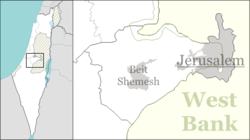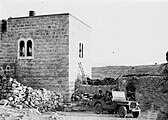
An intercontinental ballistic missile (ICBM) is a ballistic missile with a range greater than 5,500 kilometres (3,400 mi), primarily designed for nuclear weapons delivery. Conventional, chemical, and biological weapons can also be delivered with varying effectiveness, but have never been deployed on ICBMs. Most modern designs support multiple independently targetable reentry vehicle (MIRVs), allowing a single missile to carry several warheads, each of which can strike a different target. The United States, Russia, China, France, India, the United Kingdom, Israel, and North Korea are the only countries known to have operational ICBMs.
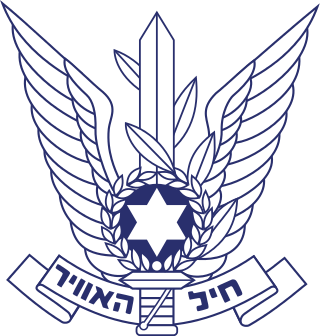
The Israeli Air Force operates as the aerial and space warfare branch of the Israel Defense Forces (IDF). It was founded on May 28, 1948, shortly after the Israeli Declaration of Independence. As of April 2022, Aluf Tomer Bar has been serving as the Air Force commander.
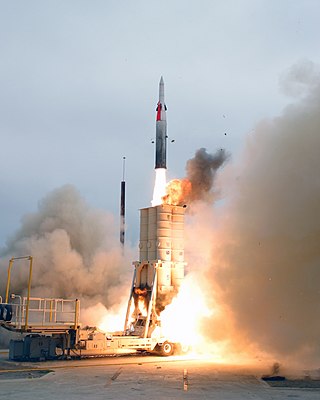
The Arrow or Hetz is a family of anti-ballistic missiles designed to fulfill an Israeli requirement for a missile defense system that would be more effective against ballistic missiles than the MIM-104 Patriot surface-to-air missile. Jointly funded and produced by Israel and the United States, development of the system began in 1986 and has continued since, drawing some contested criticism. Undertaken by the MALAM division of the Israel Aerospace Industries (IAI) and Boeing, it is overseen by the Israeli Ministry of Defense's "Homa" administration and the U.S. Missile Defense Agency. It forms the long-range layer of Israel's multi-tiered missile defence system, along with David's Sling and Iron Dome and Iron Beam.
Jericho is a general designation given to a loosely-related family of deployed ballistic missiles developed by Israel since the 1960s. The name is taken from the first development contract for the Jericho I signed between Israel and Dassault in 1963, with the codename as a reference to the Biblical city of Jericho. As with some other Israeli high tech weapons systems, exact details are classified, though there are observed test data, public statements by government officials, and details in open literature especially about the Shavit satellite launch vehicle.

An intermediate-range ballistic missile (IRBM) is a ballistic missile with a range of 3,000–5,500 km, between a medium-range ballistic missile (MRBM) and an intercontinental ballistic missile (ICBM). Classifying ballistic missiles by range is done mostly for convenience; in principle there is very little difference between a low-performance ICBM and a high-performance IRBM, because decreasing payload mass can increase range over ICBM threshold. The range definition used here is used within the U.S. Missile Defense Agency. Some other sources include an additional category, the long-range ballistic missile (LRBM), to describe missiles with a range between IRBMs and true ICBMs. The more modern term theatre ballistic missile encompasses MRBMs and SRBMs, including any ballistic missile with a range under 3,500 km (2,175 mi).

Hatzor Airbase, also titled Kanaf 4 is an Israeli Air Force (IAF) base, located in central Israel near kibbutz Hatzor after which it is named. However, there have been no fighter jets stationed there since 2021, only patrol aircraft, UAVs and defense missiles.

Ramat David Airbase is an Israeli Air Force (IAF) base located 20 km southeast of Haifa in the Northern District of Israel, close to kibbutz Ramat David in the Jezreel Valley. It is the northernmost IAF base in Israel with fighter jets, UAVs and helicopters based on it.
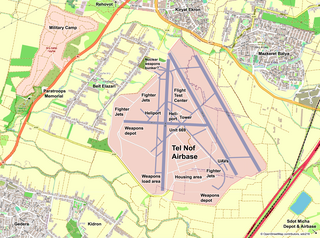
Tel Nof Airbase, also known as Air Force Base 8, is an airbase of the Israeli Air Force (IAF) located 5 km south of Rehovot, Israel. Tel Nof houses two strike fighter, two helicopter and a UAV squadron. Also located at the base is the Flight Test Center and several special units of the Israel Defense Forces (IDF), among others Unit 669 and the Paratroopers Brigade training center and its headquarters.

Nevatim Airbase, also Air Force Base 28, is an Israeli Air Force (IAF) base, located 15 km east-southeast of Beersheba, near moshav Nevatim in the Negev desert. It is one of the largest in Israel and has three runways of different lengths. Stealth fighter jets, transport aircraft, tanker aircraft and machines for electronic reconnaissance/surveillance, as well as the so-called Israeli Air Force One, are stationed there.

Hatzerim Airbase is an Israeli Air Force (IAF) base on the northern edge of the Negev desert in the Southern District of Israel, 6 km west of Beersheba, near kibbutz Hatzerim. Apart from operational fighter jets, it houses the IAF Flight Academy, the IAF Aerobatic Team and the IAF Museum.
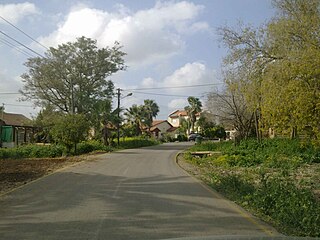
Sdot Micha or Sedot Mikha is a moshav in central Israel. Located to the west of Beit Shemesh, it is under the jurisdiction of the Mateh Yehuda Regional Council. In 2022 it had a population of 382.

Ein Shemer Airfield also called Hadera East is an Israeli Air Force (IAF) base in northern Israel, located approximately 6 km east of Hadera in the Haifa District, named after the nearby kibbutz Ein Shemer. It houses no fighter jets or helicopters but UAVs for testing and a defense missile battery with long-range radar.

Palmachim Airbase is an Israeli Air Force (IAF) base and spaceport, which the IAF and the Israel Space Agency (ISA) operate jointly. It is located west of the city of Yavne on the Mediterranean coast, 12 km south of the Gush Dan metropolitan area with Tel Aviv, named after the Kibbutz Palmachim north of it. Palmachim is a vital base in Israel's war against Hamas in Gaza. Iran simulated an attack on the base in February 2024.
Zechariah most often refers to:
Tikun Olam is a Seattle-based political blog that regularly reports on Israeli security matters. The blog was created in 2003 by Richard Silverstein and covers the Arab–Israeli conflict. Silverstein describes it as a "liberal Jewish blog" that "focuses on exposing the excesses of the Israeli national security state".

Missile defense systems are a type of missile defense intended to shield a country against incoming missiles, such as intercontinental ballistic missiles (ICBMs) or other ballistic missiles. The United States, Russia, India, France, Israel, Italy, United Kingdom, China and Iran have all developed missile defense systems.

The Arrow 3 or Hetz 3 is an exoatmospheric hypersonic anti-ballistic missile, jointly funded, developed and produced by Israel and the United States. Undertaken by Israel Aerospace Industries (IAI) and Boeing, it is overseen by the Israeli Ministry of Defense's "Homa" administration and the U.S. Missile Defense Agency. It provides exo-atmospheric interception of ballistic missiles, including intercontinental ballistic missiles (ICBMs) carrying nuclear, chemical, biological or conventional warheads. With divert motor capability, its kill vehicle can switch directions dramatically, allowing it to pivot to see approaching satellites. The missile's reported flight range is up to 2,400 km (1,500 mi).

Tikun Olam is a company that grows and supplies medical marijuana and is licensed and supervised by the Ministry of Health in Israel, the first of its kind in that country.


